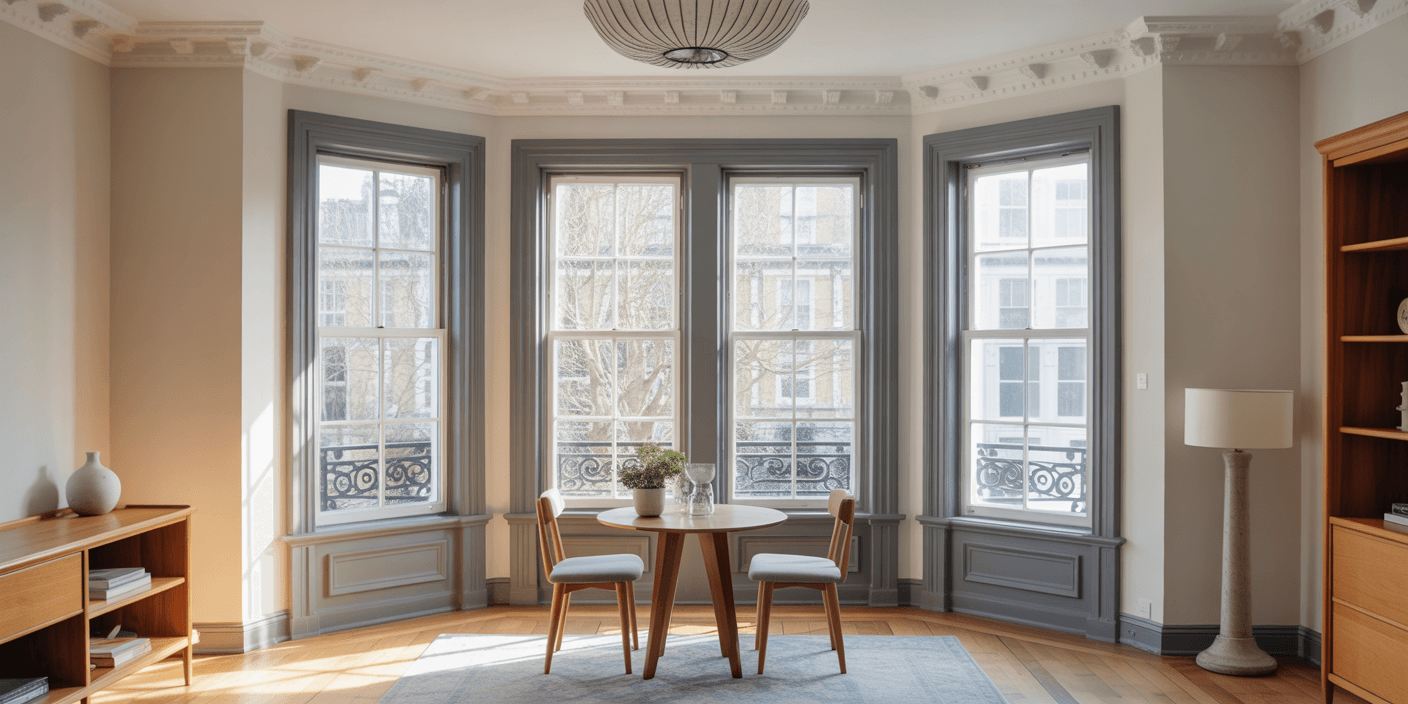The Hidden Cost of Your Current Windows
Most homeowners assume that once the windows are installed, the matter is settled. In reality, windows are not passive fixtures — they are active participants in the performance, preservation, and aesthetic integrity of the home.
If chosen poorly, windows can undermine both comfort and capital. They may permit heat loss, allow moisture ingress, compromise security, or dilute the architectural language of the building. Inherit a previous owner’s oversight — such as uPVC in a heritage façade, degraded softwood joinery, or incongruent aluminium frames — and the consequences become tangible: persistent cold spots, accelerated fabric fading, warped sightlines, and an uneasy awareness that something isn’t quite right.
These are not superficial concerns. They are cumulative failures — structural, thermal, and visual — and they carry long-term costs.
Windows occupy a unique burden in residential design. They must endure like masonry, insulate like modern building fabric, and present like joinery. Few systems meet these demands simultaneously — and fewer still without compromise.
Yet, there exists a class of windows designed precisely to resolve this conflict.
What Aluminium Clad Windows Really Are (And Why the Best Properties Choose Them)
Aluminium Clad Windows — often shortened to Aluclad — aren’t just another entry in the window catalogue. They’re a solution born of necessity: how do you deliver the warmth and character of real timber, while shielding it from a climate that chips, cracks, and peels every unprotected surface?
The answer lies in intelligent duality. Inside, you get a natural timber frame — the joinery, the grain, the tactile softness that belongs in a period home, a listed townhouse, or any space where design matters. Outside, that same frame is wrapped in powder-coated aluminium: impervious to rain, resistant to UV, immune to rot. The result is a single unit that satisfies both beauty and durability — with no need to repaint, re-stain, or apologise.
This is not cladding for cladding’s sake. It is a structural alliance between materials — bonded in a way that allows the timber to breathe, the aluminium to resist, and both to endure.
Where lesser windows force you to choose — charm or performance, tradition or technology — aluclad windows refuse the compromise entirely. That’s why you’ll find them in the homes that rarely make mistakes: architect-designed builds, heritage renovations, and passive properties that expect better from every element.
The best aluminium-clad windows don’t shout. They don’t jar with the brickwork. They don’t disrupt the line of a cornice or draw the eye away from a Georgian arch. They simply disappear — into the design, into the function, into the future.
It’s this invisibility that makes them indispensable. And it’s why, in certain circles, not specifying aluclad is beginning to look like an oversight.
The Marriage of Beauty and Resilience

Most window systems force a decision: do you want something that looks right, or something that lasts? Do you want painted timber that needs attention every few seasons — or aluminium that survives the elements but offers all the charm of a sandwich press?
With aluminium-clad windows, the answer is both.
This isn’t marketing fluff. The interior timber delivers the design warmth that modern materials haven’t yet learned to mimic. It has grain, depth, proportion — the visual DNA of a well-made home. It’s the only material that ages gracefully, rather than simply deteriorates. And when shaped and finished by craftsmen, it holds its own against the finest cabinetry, panelling, or joinery in the house.
But timber has enemies: rain, sun, frost, time. That’s why the outer face is sheathed in powder-coated aluminium — finished in any RAL colour, textured or smooth, matte or gloss, as sharp or as soft as the façade demands. The aluminium doesn’t flinch at the weather. It doesn’t crack under UV. It doesn’t swell, shrink, or sigh under British winters.
Together, they perform a quiet duet. The timber gives the warmth; the aluminium gives the shield. You get elegance with endurance. And you get a frame that resists every external pressure without ever betraying what it’s holding up.
It’s in this marriage of materials that the real genius lies — and why the best-designed homes refuse to settle for anything less.
For homeowners seeking peace of mind without aesthetic surrender, aluminium-clad windows are not just a sensible option. They’re a declaration: you don’t have to choose between beauty and performance anymore.
Behind the Cladding: What Quality Looks Like (And What It Doesn’t)
From the outside, all aluminium-clad windows look alike. Smooth lines. Clean finishes. Matching colours. It’s only when time — or scrutiny — applies pressure that the truth emerges.
The truth is this: not all aluclad windows are engineered equally. Many aren’t even engineered at all.
In the race to offer a ‘composite’ product, mass manufacturers have flooded the market with timber-aluminium hybrids that barely qualify as either. Laminates posing as hardwood. Aluminium skins glued, not ventilated. Cores packed with filler material. Joints that betray their haste. U-values calculated optimistically. Finishes that fade before the warranty is even cold.
Worse still, most consumers — even specifiers — don’t know what to look for. Aluminium clad becomes a category, not a craft.
But the difference is everything.
A true aluclad window is not a compromise. It’s a fusion. The timber must be engineered — finger-jointed, laminated, pressure-treated — not just cut and framed. The aluminium must be ventilated and thermally broken, not glued flush to the wood. The cladding must be removable for maintenance, not permanently bonded. Every joint must be tight. Every corner must invite inspection. Every edge must feel like the product of care, not cost-saving.
This is not something you get off the shelf. It’s something built — and built to last — by people who understand more than manufacturing. They understand architecture. Planning law. Aesthetic integrity. Longevity.
This is where Sash Windows London separates from the crowd. Not with noise. With the kind of quiet competence that doesn’t need explanation — only comparison.
And when that comparison is made, the choice becomes very clear indeed.
Navigating Regulation Without Compromise
For anyone building, renovating, or specifying in the UK, the rules are no longer optional — and they’re not simple.
Energy efficiency, security, sightlines, safety. The days of choosing a window by appearance alone are over. Today, a window has to perform on paper long before it’s ever installed in brick.
This is where most products — and many providers — begin to stumble.
Start with Part L of the Building Regulations: thermal performance. It mandates U-values low enough to retain heat and reduce energy consumption. Poorly insulated timber? Fails. Budget aluminium? Fails. Composite hybrids that aren’t truly thermally broken? You guessed it — fail.
Next comes Part Q: a regulation few homeowners have even heard of, but one that demands windows meet strict security standards for new builds and conversions. Softwood alone won’t do. Cheap locks won’t do. And unless the window is certified to resist forced entry, the entire spec may be rejected.
Then there’s Part K, governing safety and impact resistance — particularly for windows at low level or near doors. Laminated glass, correct markings, proper installation heights: get it wrong, and the inspector’s red pen writes the final word.
It sounds exhausting. But with the right system — and the right partner — it becomes effortless.
Aluminium Clad Windows, done properly, meet or exceed every one of these standards. Triple glazing? Achievable. Laminated units with acoustic dampening? Standard. PAS 24 security rating? Already part of the spec. Thermal transmittance down to 0.8 W/m²K? Not just achievable — guaranteed.
Sash Windows London doesn’t just meet the rules. It anticipates them. It bakes them into the process from the first consultation — whether the home is in a conservation area, a Passive House build, or simply a homeowner’s final home.
Compliance, in their hands, isn’t an obstacle. It’s an asset.
Performance Without Apology: U-Values, Glazing, and Soundproofing

Windows, for most people, are emotional. They frame light, shape space, set the mood. But when chosen poorly, they also frame ongoing regret.
Which is why the best windows don’t just look right — they perform. Quietly. Reliably. Without apology.
Start with the basics: U-values. They measure heat loss — and the lower, the better. A good double-glazed unit might deliver 1.2 W/m²K. A high-performance triple-glazed aluclad window, engineered properly, can go as low as 0.8 W/m²K. That’s Passive House territory. Not aspirational. Achievable.
But performance isn’t just thermal. It’s also acoustic.
In an age of rising noise pollution — traffic, aircraft, neighbours, the outside world you didn’t invite in — acoustic glazing is no longer a luxury. It’s the cost of silence. Laminated units, asymmetric panes, argon fills: all invisible from the outside, but immediately noticeable when you close the window and the world disappears.
Then there’s the frame. Most windows fail here. It’s not enough to have efficient glass if the surrounding material acts like a radiator. Which is why thermally broken aluminium is critical. It interrupts heat transfer through the frame itself — so the insulation isn’t just in the glazing, it’s in the bones.
Put this all together and you don’t just meet code. You transcend it.
You get a home that stays warmer in winter, cooler in summer, quieter all year round — and all without sacrificing sightlines, proportions, or the architectural story your property is trying to tell.
Sash Windows London has spent decades refining the balance between form and function — creating window systems that pass technical scrutiny and pass the feeling test too.
Because performance isn’t just a number. It’s how your home feels at 5 am in January… or at 11 pm when the party next door forgets it has neighbours.
And if a window can answer both, it’s doing more than its job.
What to Expect From the Right Manufacturer
At this level, you’re not buying windows. You’re investing in outcomes. Performance, longevity, harmony with your architecture. And outcomes don’t come from catalogues — they come from craftsmanship, process, and people.
That’s why the difference between a supplier and a manufacturer is not academic. It’s architectural.
The right manufacturer isn’t just cutting timber and powder-coating aluminium. They’re interrogating your plans, liaising with your architect, aligning every angle with Building Regulations, conservation requirements, acoustic expectations, and solar orientation.
They’re not just selling you what they have. They’re building what your project demands — and guaranteeing it fits.
You should expect:
- Factory control: not parts assembled across borders, but precision-engineered units produced under one roof.
- Tailored lead times: not dictated by ferry schedules from Scandinavia, but scheduled in the UK, measured in weeks.
- RAL-matched finishes: that align with your doors, frames, or exterior palette — not “close enough” approximations.
- Heritage-matching sightlines: for listed or conservation properties where millimetres matter.
- Complete documentation: with thermal modelling, security compliance (PAS 24), and glazing specs — ready for planners, architects, and Building Control.
In other words, they don’t add friction. They remove it. Quietly, confidently, completely.
And when it’s done right, the window disappears — not just visually, but as a concern.
Sash Windows London has made this their specialty: marrying deep product understanding with the exacting standards of homeowners, developers, and architects who refuse to compromise.
Because getting the window right isn’t the final touch. It’s the foundation that makes the rest of the build feel inevitable.
Ready to Build Without Compromise?
The best decisions in a home aren’t loud. They don’t announce themselves with clickbait or urgency. They sit quietly in the background — working, lasting, disappearing into the architecture, while lesser choices crumble, warp, or beg for repair.
Choosing the right window system isn’t about ticking a box. It’s about future-proofing your design intent. It’s about insulation that performs like a passive envelope — without screaming ‘modern’ in a Georgian frame. It’s about a supplier who speaks Building Regs fluently and treats your elevation drawings like sacred text.
And it’s about knowing, years from now, that you got it right.
Sash Windows London has spent decades helping homeowners, architects, and developers make the kinds of decisions that don’t need to be remade. They don’t do flash. They don’t do gimmicks. They do beautifully engineered window systems — delivered with precision, expertise, and total respect for the homes they’re entering.
You don’t have to chase perfection. You just have to protect it.
✅ Book a design consultation
Whether you’re restoring a heritage property, building from scratch, or upgrading with intelligence — start with a conversation that doesn’t sound like a sales pitch.
Let’s make your windows the quietest decision you’ll never regret.







